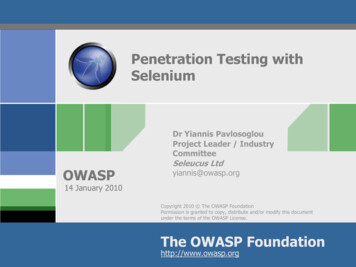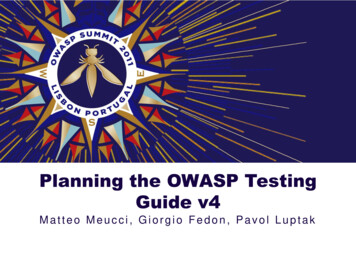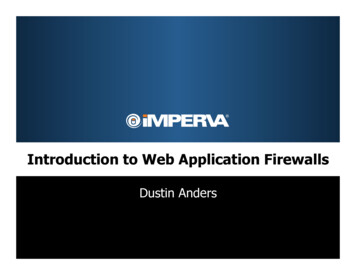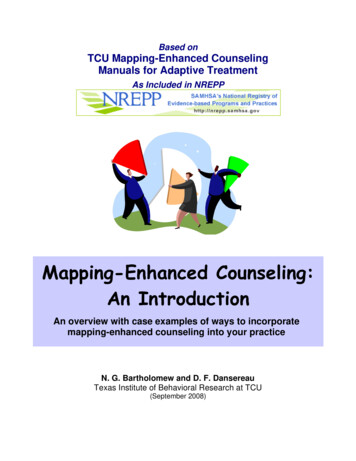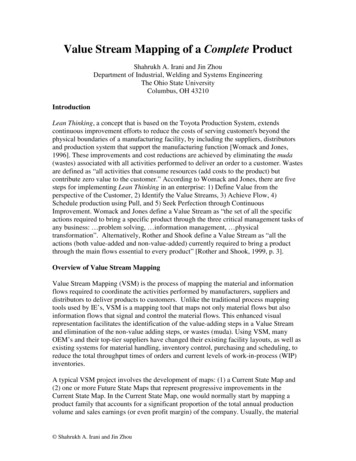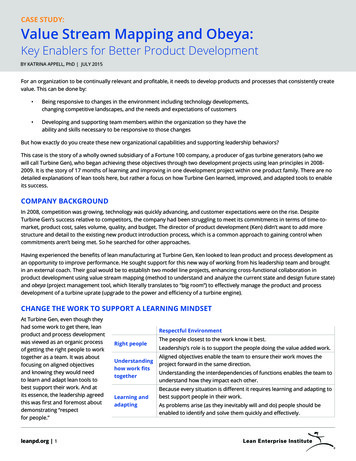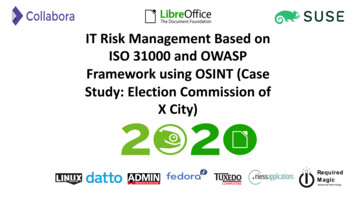
Transcription
Annals of Emerging Technologies in Computing (AETiC)Vol. 4, No. 3, 2020Research ArticleVulnerabilities Mapping based onOWASP-SANS: A Survey for StaticApplication Security Testing (SAST)Jinfeng LiDepartment of Electrical and Electronic Engineering, Imperial College London, London, UK1jinfeng.li@imperial.ac.ukCorrespondence: jinfeng.li@imperial.ac.ukReceived: 17th March 2020; Accepted: 7th April 2020; Published: 1st July 2020Abstract: The delivery of a framework in place for secure application development is of real value forapplication development teams to integrate security into their development life cycle, especially when amobile or web application moves past the scanning stage and focuses increasingly on the remediation ormitigation phase based on static application security testing (SAST). For the first time, to the author’sknowledge, the industry-standard Open Web Application Security Project (OWASP) top 10 vulnerabilitiesand CWE/SANS top 25 most dangerous software errors are synced up in a matrix with Checkmarxvulnerability queries, producing an application security framework that helps development teams reviewand address code vulnerabilities, minimise false positives discovered in static scans and penetration tests,targeting an increased accuracy of the findings. A case study is conducted for vulnerabilities scanning of aproof-of-concept mobile malware detection app. Mapping the OWASP/SANS with Checkmarxvulnerabilities queries, flaws and vulnerabilities are demonstrated to be mitigated with improved efficiency.Keywords: Application Security; Checkmarx; Malware Detection; OWASP Top 10; SANS Top 25; StaticApplication Security Testing; Vulnerability Mapping1. IntroductionWith the prevalence of Internet of Things devices [1] and unprecedented flows of data [2] in the4G to 5G revolution [3–5] at an exponential pace, the security of web and mobile applications is beingincreasingly challenged and has gained considerable research interest underpinning a wide varietyof industries beyond banking, financial services and insurance (BFSI), such as e-commerce [6],healthcare, telecommunications [7], media, entertainment, retail, education, as well as governmentand national defense. In this respect, there is arguably an ongoing need for investing massively in theapplication security sector which enables technological advances for a smarter world. Valued USD 4billion in 2019, the sharply growing global market in application security is projected to reach USD 9billion by 2022, and USD 15.25 billion by 2025 at a compound annual growth rate of 25% [8–10].The amount of easily downloaded mobile applications is constantly on the increase meaningthat mobile phones are increasingly vulnerable to malware and other malicious code [10]. Currently,the use of mobile anti-malware systems is not widespread with customers complaining thatJinfeng Li, “Vulnerabilities Mapping based on OWASP-SANS: A Survey for Static Application Security Testing (SAST)”,Annals of Emerging Technologies in Computing (AETiC), Print ISSN: 2516-0281, Online ISSN: 2516-029X, pp. 1-8, Vol. 4, No. 3, 1stJuly 2020, Published by International Association of Educators and Researchers (IAER), DOI: 10.33166/AETiC.2020.03.001,Available: http://aetic.theiaer.org/archive/v4/v4n3/p1.html.
AETiC 2020, Vol. 4, No. 32advertisements and irritating notifications discourage them from using scanners. A customisableanti-malware application is developed in this work which scans APK code files from all otherdownloaded applications and uses machine learning algorithms to identify potentially maliciouscode, providing an advert-free experience with only necessary notifications.Note that embedding security into an application development lifecycle (DLC) encompasses aset of different techniques [11] and assessments at different stages, e.g. Static Application SecurityTesting (SAST) [12] at an early stage of DLC, and Dynamic Application Security Testing (DAST) [13]at testing and operation stages. SAST scans source code like a white box testing from the inside out,while DAST implements black box testing of the runtime behavior while executing it from the outsidein. Comprehensive application security solutions are highly desirable to maximise the coverage ofever-evolving cyberattacks. Among the industry standards of the most critical application securityrisks, Open Web Application Security Project (OWASP) Top 10 [14] and SANS Common WeaknessEnumeration (CWE) top 25 most dangerous software errors [15, 16] are well acknowledged.However, few studies to our knowledge have synced up and mapped the OWASP top 10 with theSANS top 25. This work bridges the gap by performing SAST using Checkmarx, a state-of-the-artsource code static scanning tool to identify flaws and vulnerabilities, with the advantages andlimitations reviewed in Section 2. A survey on OWASP risk rating methodology is presented inSection 3, followed by the code vulnerabilities mapping into a novel matrix of OWASP Top 10 andSANS top 25 in Section 4 for optimising the checkmark based SAST. A case study incorporating theproposed vulnerabilities mapping is demonstrated for the anti-malware application in Section 5.2. Current Status of SAST based on CheckmarxIn contrast with other application security testing methods (such as DAST which struggles toadequately identify crucial problems within the application layer nor indicate how or where to fixthem), SAST based on un-compiled source code analysis offers comprehensive solution intovulnerable patterns and coding flaws from the root up [12]. Specifically, the advantages ofCheckmarx-based SAST are summarised below: Integrated into delivery pipelines. The SAST service aims at not only providingassurance to security solution consultants, but also enabling developers to write anddeliver secure code - this is primarily achieved by integrating the SAST tools into theestablished development and/or delivery pipeline processes which helps developersdiscover and fix vulnerabilities long before a project reaches the testing phase. Fast and automated. Checkmarx-based SAST technology identifies criticalvulnerabilities (e.g. SQL injection and cross-site scripting), allowing instant andrelatively accurate feedback on the code with automation, e.g. precisely locating the linenumber with flaws. Low cost. The ability to remediate issues as they arise makes it ideal for integrationwithin the software development lifecycle (SDLC), which saves precious time,remediation efforts and expenses.However, the current status of SAST tools is susceptible to the following drawbacks [17, 18]. A large number of false positives and negatives reported, which struggles to confirmthat an identified security issue is an actual vulnerability. As a consequence,considerable effort is required for developers to manually identify and remediate theissues. A limited percentage of application security flaws can be found automatically. It is stillchallenging to automatically locate a few types of security vulnerabilities (e.g.authentication problems, access control issues, insecure use of cryptography, etc). Limited code coverage, i.e. SAST struggles to locate issues in libraries, configurations,and frameworks, since they are not represented in the code. The incapability of reviewing compiled source code and identifying business logicvulnerabilities.www.aetic.theiaer.org
AETiC 2020, Vol. 4, No. 333. Methodology in OWASP Risk RatingDriven by an opensource application security community, the OWASP Top 10 is an industrystandard of the most critical application security risks. The metrics of OWASP is based on a coupleof likelihood factors, e.g. weakness prevalence, detectability, exploitability, and technical impactfactor [19]. As illustrated in Figure 1 below, the risk rating of the flaws proposed by OWASP iscalculated based on two steps. First, average three likelihood factors (i.e. prevalence, detectability,and exploitability), obtaining a likelihood rating. The scale of each risk likelihood factor ranges from1 (low) to 3 (high). Second, multiply the obtained likelihood rating with a technical impact factorranging from 1 (low) to 3 (high).Figure 1. Methodology of Calculating the OWASP Top10 Risk Rating.Based on the above risk rate calculating mechanism, the top 10 vulnerabilities in 2017 [14] aresummarised with the corresponding likelihood factors detailed in Figure 2.Figure 2. Decomposition Analysis of the OWASP Top 10 (Horizontal Axis: 1. Injection Attack, 2. BrokenAuthentication, 3: Sensitive Data Exposure, 4. XML External Entities (XXE), 5. Broken Access Control, 6.Security Misconfiguration, 7. Cross-Site Scripting (XSS), 8. Insecure Deserialization, 9. Using Components withKnown Vulnerabilities, 10. Insufficient Logging and Monitoring).Over the last few years, attack methods [8–13] have grown with the evolution of fundamentaltechnology and architecture of applications (e.g. JavaScript attacks [20], and attacks on cloudcomputing services [21]), and hence the update [14] of OWASP Top 10 as illustrated in Table 1 below.www.aetic.theiaer.org
AETiC 2020, Vol. 4, No. 34Table 1. Evolution of OWASP Top 10 from 2013 to 2017 [14].4. Novel OWASP-SANS Vulnerabilities MappingOne of the novelty in this work is mapping the co-occurrence of high-profile vulnerability typesfrom both OWASP Top 10 and CWE/SANS Top 25. The obtained matrix is presented in Table 2according to up-to-date documentation, i.e. 2017 for OWASP [14] and 2019 for CWE/SANS [16].Table 2. A Novel Vulnerabilities Mapping based on OWASP-SANS/CWE.OWASP RankOWASP VulnerabilitySANS CWE IDCWE-78: OS Command Injection (Improper Neutralization of SpecialElements used in an OS Command)CWE-89: SQL InjectionCWE-94: Code Injection1InjectionCWE-434: Unrestricted Upload of File with Dangerous TypeCWE-494: Download of Code Without Integrity CheckCWE-829: Inclusion of Functionality from Untrusted Control SphereCWE-306: Missing Authentication for Critical FunctionCWE-307: Improper Restriction of Excessive Authentication AttemptsCWE-798: Use of Hard-coded Credentials2Broken AuthenticationCWE-807: Reliance on Untrusted Inputs in a Security DecisionCWE-862: Missing AuthorizationCWE-863: Incorrect AuthorizationCWE-311: Missing Encryption of Sensitive Data3Sensitive Data Exposure5Broken Access ControlCWE-319: Cleartext Transmission of Sensitive InformationCWE-73: External Control of File Name or PathCWE-285: Improper AuthorizationCWE-250: Execution with Unnecessary Privileges6Security Misconfiguration7Cross-Site Scripting (XSS)CWE-676: Use of Potentially Dangerous FunctionCWE-732: Incorrect Permission Assignment for Critical ResourceCWE-79: Improper Neutralization of Input During Web Page Generation(Cross-Site Scripting)8Insecure DeserializationCWE-134: Use of Externally Controlled Format StringCWE-190: Integer Overflow or WraparoundUsing Components with9Known VulnerabilitiesCWE-327: Use of a Broken or Risky Cryptographic AlgorithmCWE-759: Use of a One-way Hash Without a Saltwww.aetic.theiaer.org
AETiC 2020, Vol. 4, No. 355. SAST Demonstration on a Proof-of-concept Malware Detection PrototypeA mobile antivirus software prototype for an Android phone is developed, targeting thefunctionality of scanning a phone for known flaws and detecting unknown vulnerabilities. The mainfunctional requirements are summarised as follows: Customise scan schedule or force immediate scans. Monitor potential incoming threats before they are downloaded onto the device. Quarantine or block applications that are high-risk and vulnerable. View past trends in found vulnerabilities. Learn about the dangers of leaving a mobile phone insecure and other cyber-threats. Advert-free experience with only necessary notifications.Checkmarx is employed to perform SAST on the Bitbucket source repository, examining theblueprint of the application without executing the code. By carefully investigating file locations thatreported by the Checkmarx vulnerability queries, we observe that 90% of the issues originate fromthe externally developed libraries used in the python framework (Flask and TensorFlow), which areconsidered out of scope (marked yellow in Table 3 below) and filtered for a rescan. Only the fileinternally developed (marked in red below) needs more remediation attention at this stage. Thestatistics of the initial scanning covering the whole Bitbucket source repository and the rescanningexcluding the aforementioned external libraries are reported in Table 4.Table 3. Checkmarx Initial Scan of the Whole Repository including all Libraries.Table 4. Scanning Statistics of the Bitbucket Source Repository.Lines of Code ScannedScan TimeFiles ScannedCoding LanguageInitial Scan1377471h:56m:42s605Python and JSRescan31160h:01m:01s198Python and JSRescan results are analysed in Figures 3 and 4, with 17 vulnerabilities reported in total, exhibitingvarying degrees of severity (categorised in high, medium and low). Checkmarx vulnerability queriesare mapped with the proposed matrix of OWASP Top 10 and SANS CWE in Table 5, producing astate-of-the-art vulnerabilities matrix guiding application development teams and applicationsecurity consultants for code remediation.www.aetic.theiaer.org
AETiC 2020, Vol. 4, No. 36Figure 3. Checkmarx Rescanning Results Summary and Locations of the Most Vulnerable Files.Figure 4. Checkmarx Rescanning Results of the Top 5 Vulnerabilities.Table 5. OWASP-SANS Vulnerabilities Mapping with Checkmarx Vulnerability Queries.The above flaws (7 highs and 6 mediums as mentioned in Figure 4) are remediated accordinglyincorporating the matrix of Checkmarx queries, OWASP, and SANS, as demonstrated by the finalround of Checkmarx scanning result shown in Figure 5. Only 1 low vulnerability remains, indicatingthat the application development team can prove closure of the main vulnerabilities.www.aetic.theiaer.org
AETiC 2020, Vol. 4, No. 37Figure 5. Checkmarx Third-round Scanning Results (Compared with the Second-round Scanning).6. ConclusionThis work reviews the recent advances in static application security testing (SAST) and proposesa novel matrix of vulnerabilities mapping based on synchronising the industry-standard OWASP top10 vulnerabilities, SANS/CWE top 25 most dangerous software errors, and Checkmarx vulnerabilityqueries. With the produced application security framework, enhanced code integrity is demonstratedfor a proof-of-concept malware detection application in Android devices through 3 rounds ofCheckmarx-based SAST which assists decision making in flaws remediation and vulnerabilitiesmitigation. The OWASP-SANS matrix-based security framework pioneered in this work canpotentially be integrated with other state-of-the-art SAST scanners to expand the security testingscenarios for mobile and web applications.References[1]Ahmad U., Chaudhary J., Ahmad M. and Naz A.A., "Survey on Internet of Things (IoT) for DifferentIndustry Environments", Annals of Emerging Technologies in Computing (AETiC), vol. 3, no. 3, July 2019, pp.28–43. Available: ]Guo X. Y. and Li J. F., "A Novel Twitter Sentiment Analysis Model with Baseline Correlation for FinancialMarket Prediction with Improved Efficiency", in Proceedings of the Sixth International Conference on SocialNetworks Analysis, Management and Security (SNAMS), Granada, Spain, Oct. 2019, pp. 472–477.Available: https://ieeexplore.ieee.org/document/8931720[3]Li J. F., Xu H. and Chu D.P., "Design of liquid crystal based coplanar waveguide tunable phase shifter withno floating electrodes for 60–90 GHz applications", in Proceedings of the 2016 46th European MicrowaveConference (EuMC), London, 2016, pp. 1047–1050. Available: https://ieeexplore.ieee.org/document/7824526[4]Li J. F. and Chu D.P., "Liquid crystal-based enclosed coplanar waveguide phase shifter for 54–66 GHzapplications", Crystals, vol. 9, 12, 650, December 2019. Available: https://doi.org/10.3390/cryst9120650[5]Li J. F., "Structure and Optimisation of Liquid Crystal based Phase Shifter for oi.org/10.17863/CAM.35704[6]Miraz M. H. and Ali M., "Applications of Blockchain Technology beyond Cryptocurrency", Annals ofEmerging Technologies in Computing (AETiC), vol. 2, no. 1, January 2018, pp. 1–6. /p1.html[7]Peter S. Excell, "The British Electronics and Computing Industries: Past, Present and Future", Annals ofEmerging Technologies in Computing (AETiC), vol. 2, no. 3, July 2018, pp. 45–52. /p5.html[8]Medeiros I., Neves N. and Correia M., "Detecting and Removing Web Application Vulnerabilities withStatic Analysis and Data Mining", IEEE Transactions on Reliability, vol. 65, no. 1, pp. 54–69, March 2016.Available: tic.theiaer.org
AETiC 2020, Vol. 4, No. 3[9]8Shakdher A., Agrawal S. and Yang B., "Security Vulnerabilities in Consumer IoT Applications", 2019 IEEE5th Intl Conference on Big Data Security on Cloud (BigDataSecurity), IEEE Intl Conference on HighPerformance and Smart Computing (HPSC) and IEEE Intl Conference on Intelligent Data and Security(IDS), Washington, DC, USA, 2019, pp. 1–6. Available: https://ieeexplore.ieee.org/document/8819463[10] Lin Y., Huang C., Wright M. and Kambourakis G., "Mobile Application Security", Computer, vol. 47, no. 6,pp. 21–23, June 2014. Available: https://ieeexplore.ieee.org/document/6838873[11] Rafique S., Humayun M., Gul Z., Abbas A. and Javed H, "Systematic Review of Web Application SecurityVulnerabilities Detection Methods", Journal of Computer and Communications, 2015. [12] Yang J., Tan L., Peyton J. and Duer K.A., "Towards Better Utilizing Static Application Security Testing",2019 IEEE/ACM 41st International Conference on Software Engineering: Software Engineering in t/document/8804441[13] Petukhov A. and Kozlov D., "Detecting Security Vulnerabilities in Web Applications Using DynamicAnalysis with Penetration Testing", Proceedings of the Application Security Conference, 2008. AppSecEU08-Petukhov.pdf[14] OWASP, "OWASP Top 10 - 2017 The Ten Most Critical Web Application Security Risks", Open asp.org/www-pdf-archive/OWASP Top 10-2017 %28en%29.pdf.pdf[15] Howard M., "Improving Software Security by Eliminating the CWE Top 25 Vulnerabilities", IEEE Security& Privacy, vol. 7, no. 3, pp. 68–71, May-June 2009. Available: https://ieeexplore.ieee.org/document/5054914[16] SANS, "CWE/SANS TOP 25 Most Dangerous Software Errors", SANS Institute, 2019, /2019 cwe top25.html[17] Wang Y. and Alshboul Y., "Mobile security testing approaches and challenges", 2015 First Conference e.org/document/7072880[18] Rafique S., Humayun M., Hamid B., Abbas A., Akhtar M. and Iqbal K., "Web application securityvulnerabilities detection approaches: A systematic mapping study", 2015 IEEE/ACIS 16th InternationalConference on Software Engineering, Artificial Intelligence, Networking and Parallel/DistributedComputing (SNPD), Takamatsu, 2015, pp. 1–6. Available: https://ieeexplore.ieee.org/document/7176244[19] Ramadlan M.F., "Introduction and implementation OWASP Risk Rating Management", Open WebApplication Security Project, 2019. Available: ment170615172835.pdf[20] Ndichu S., Ozawa S., Misu T. and Okada K., "A Machine Learning Approach to Malicious JavaScriptDetection using Fixed Length Vector Representation", 2018 International Joint Conference on NeuralNetworks (IJCNN), Rio de Janeiro, 2018, pp. 1–8. Available: https://ieeexplore.ieee.org/document/8489414[21] Duncan A., Creese S. and Goldsmith M., "A Combined Attack-Tree and Kill-Chain Approach to DesigningAttack-Detection Strategies for Malicious Insiders in Cloud Computing", 2019 International Conference onCyber Security and Protection of Digital Services (Cyber Security), Oxford, United Kingdom, 2019, pp. 1–9.Available: https://ieeexplore.ieee.org/document/8885401 2020 by the author. Published by Annals of Emerging Technologies in Computing(AETiC), under the terms and conditions of the Creative Commons Attribution (CC BY)license which can be accessed at ic.theiaer.org
mitigation phase based on static application security testing (SAST). For the first time, to the author’s knowledge, the industry-standard Open Web Application Security Project (OWASP) top 10 vulnerabilities and CWE/SANS top 25 most dangerous


